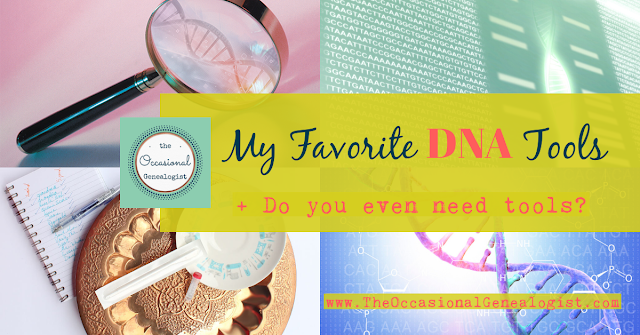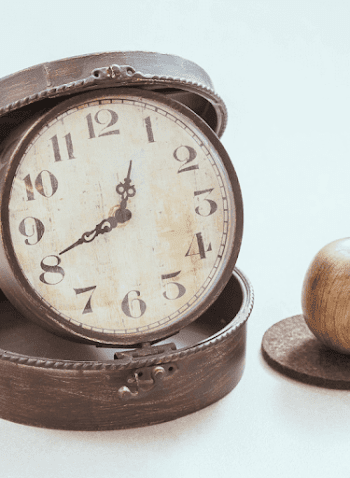
You came here today because you want the best DNA tools.
OOOOOO, sounds so promising.
You're going to break down all your brick walls by picking the perfect tools, easily executing them, and then you'll sit back and relax under your lush family tree.

|
| ahhh, relaxing under the family tree |
No. You're not.
Genetic genealogy doesn't work that way.
I am going to talk about what I consider the best DNA tools but with a huge caveat.
Most people don't need a bunch of DNA tools.
If you're Googling and Pinterest searching for the best DNA tools, you could probably be better spending your time. So why are tools so popular and do you need them at all?
First, tools always make us think we'll accomplish more, easier. This can happen but that's the exception in genetic genealogy.
Genetic genealogy is not easy, it is not fast.
It is a tool in itself (see, we THINK tools will be like a magic wand, but they involve hard work---just imagine hand tools. You'll get a lot farther with a saw than your hands, but using it is nothing like a magic wand).
I want to quickly pull this whole idea together and get onto talking about making progress so here's my analogy.
You want to break down a brick wall. It doesn't matter if you're an adoptee, or seasoned genealogist, or just got hooked through an online research site. You want to find one or more new ancestors.
You've got genealogy tools for this, both traditional tools and DNA. You may know how to use some of the tools and not others. You're hoping DNA is a wrecking ball that will demolish your brick wall.

When you pull it out you probably don't know which end is up, more or less how to use it. You know if you're the type that looks for the manual or just wings it. (Hint: if you can't tell which end goes up, you need to at least flip through the manual!).
I'm not going on with the analogy related to learning to use DNA. Somehow, you've managed to flip a switch on your DNA tool (that's how you got here) and you got...
a flashlight?!?!
OOOOO (this time in sarcasm), you're really going to break down that brick wall with a flashlight. DNA might throw some light on your problem but you want power tools! This is like a Dremel flashlight, you can get all sorts of accessories, surely using these tools will break your brick wall!
It's still a flashlight.
Or is it?
If you find the correct switch, you'll find DNA is a laser. You can cut apart that brick wall with precision (I'll take it one better, DNA is your genealogical lightsaber, if you can figure out how to turn it on---and you won't even need the Force to wield it!).
So why did I pick this analogy?
If you are running around accumulating DNA tools, you've got DNA in flashlight mode. You're scattering its (potential) power everywhere and that makes it ineffective.
If you FOCUS, you will have a really powerful tool.
This is also "using the right tool for the job."
- DNA can not solve every genealogical problem.
- Not every DNA tool is needed for every problem that can be solved with DNA
So before I tell you what I think are the best DNA tools, you need to decide...
- Do you need to keep working with the manual before investing in accessories?
- Do you have a specific problem and you just need to identify the right accessory?
Notice there's another step involved here.
You need to have a goal, a specific problem to solve.
There are so many DNA tools out there, you can't learn to use all of them in theory before you need to apply them to a specific problem. You might learn to use some, but will that be the one you need? It is easier to learn to use a tool by using it and making progress (the progress on a goal will keep you motivated far longer than just "testing" how a tool works).
So figure out where you fall.
- If you need to read the manual (i.e. learn to use DNA) you're almost done with this post. I've got some simple advice for you.
- If you have a specific project, I may not mention the right tool for you, or I might. You need to know what you need to accomplish for "success."
- You might be beyond the manual but not to a specific problem. Realize you won't find "success" without a goal. There's nothing wrong with just learning but realize you've got DNA in flashlight mode AND you don't even have a brickwall to work on.
So what about these "best" DNA tools?
DNA Tools for Beginners
The first tool you need to learn to use is your testing company's site (including its built-in tools). The average genetic genealogist (a hobbyist) can stick with this for a really long time.
The "tool" you will need to add on is organization. Right now, there isn't one phenomenal way to organize DNA. It's still too new. Your organization system should be totally unique taking into account your personal preferences, where you tested, what project you are working on (so you might organize different projects differently), and what tools you decide to actively use.
This is fairly different from traditional research which needs to fit on a similar framework for everyone (I've seen people try to toss this framework for "modern" options but that will come back to bite you in the end---because genealogy goes on and on, that framework stops it from collapsing as you pile on more and more).
In the last three years, I've seen a shift in what's considered "essential" for using DNA for genealogy. My personal experience would agree with this shift but we don't have decades of experience to be sure what is best in the long term.
For now, you need to "be organized" but that can shift and change as we (genealogists) learn more about using DNA for genealogy.
If you're still in the manual reading stage, you could stop there as far as actual tools. You might need some reference materials to help you but not "tools."
A DNA Tool for Everyone
The one exception is my favorite reference material turned tool.
That is the Shared cM Tool from DNAPainter. This is a tool a beginner could master and the time spent would be well worth it. (Realize this IS reference material turned into a tool so it is not required).
In a nutshell, you plug in the cMs between test taker and match and get a table of the statistical likelihood for relationships. This is what you now get from AncestryDNA when you click on the shared cMs but the underlying statistics are slightly different so the two tables will probably be different. Since shared DNA leading to a relationship is an estimate, anyway, I consider getting two (easy to access) suggestions a benefit. For other companies, you will find using the DNAPainter tool provides more information.
RELATED: Learn more about using the tools at AncestryDNA in this post.
You can imagine why this tool helps you work towards finding new ancestors but I've also found it helps me learn. Easily having the statistical information makes it much clearer why shared cMs can only take you so far (much larger cMs help you include a few most likely relationships but it's amazing how fast you find you're excluding a few least likely relationships). You'd never play around with the statistics if it was hard.
Learning from Shared DNA
Although I've recommended this tool as "beginner-friendly," I find it really powerful when you are really focused and have done a lot of work. At that point, you can exclude relationships based on research.
When you are faced with a few unlikely relationships and everything else being statistically equal, you can see how this plays out when you exclude some relationships based on reasearch. Essentially, you can exclude both statistically unlikely relationships plus unlikely (or impossible) relationships based on research. Sometimes this narrows the options way down.
You can also easily compare with matches who are close relatives to each other, too. This can lead to even more focus, this time by focusing on just a few remaining likely relationships. If you have close relatives in different generations, this is ideal. Hopefully you can see tree-building and a statistical table are both HUGE benefits and you only need one simple tool.
DNAPainter actually offers another tool that does something similar.
Intermediate DNA Tools
I don't recommend this for beginners. You have to have a specific goal to use this tool and some research (i.e. the trees of matches) to go with it.WATO
This is "What Are The Odds" referred to as WATO. I absolutely love this tool but it seems I'm terribly abusing it.Those of you who've read many of my DNA posts know my entire family is southern. I'm not quite my own grandpa but there are days it feels like it.
None of these tools are meant to work on cases of endogamy or multiple close relationships. However, they also run the statistics really fast so I'm going to give them a try in my situation and I usually find they help, if not work as intended (all the tools I'm mentioning work as intended if used as intended, my family, and many of my clients, who are fighting with the same kind of southern DNA, just have ancestry outside the realm of distinct branches).
WATO requires you to enter lineages (for your matches) to a common ancestor, along with the cMs. Then you enter hypotheses for the tool to test. These are the possible relationships of the test taker.
I've been told this works best on relatively recent relationships (still within "genealogy" but likely not beyond around a shared ancestor in the mid-1800s---obviously having several really old matches and a really old test taker could change that date --- it's not a firm number of generations or a firm date but the date is related to the number of generations involved and that's always "wobbly" with genealogy).
I've used WATO for a colonial American shared ancestor and I still found it helpful.
I realized I did something "unusual" which was have dozens of matches. And if the shared ancestor is in colonial America, you are far more likely to have dozens of matches from that one person.
This is how statistics works. More "data" smoothes things out. My problem was I had too much data to "think" through and I was not going to run any statistical calculations (I have a statistics background but I never used it. I got a job as a genealogist after temping the first year out of grad school. I understand how statistics work but I don't remember the specifics well enough to just calculate something---I'd rather go build some more trees in that time!).
WATO is a way to make sense out of all that information. I don't find it gives an answer in this kind of case but it can help you exclude options or prioritize. Given how much time genetic genealogy takes, these are just as important.
At the least, if you're thinking an option is something unreasonable, WATO will make that obvious (and you'll be going "doh" but better that than wasting time chasing a highly unlikely or impossible lead).
Note that I've just told about two DNAPainter tools that have nothing to do with DNAPainter's primary feature which is chromosome mapping. I wouldn't put chromosome mapping on my "best" tools list. It is a best tool for specific problems. Remember, you want the right tool for the job. Chromosome mapping is very time-consuming. Choose it when it is really what you want, not when you're looking for a quick answer or are just starting.
GEDmatch
In the realm of "best tools" I have to mention GEDmatch in general. It is actually a collection of tools which makes it hard to learn to use but I recommend using it, or more specifically, uploading your results there so you will be ready to learn and use specific tools when you need them.Rather than get too specific, realize if you're still in the manaul reading stage, upload to GEDmatch but keep focusing on your testing company until you have a specific problem that needs GEDmatch (or you have enough basic skills to start expanding your knowledge).
I have another "in-general" tool. Like WATO, I don't recommend this for beginners. You will be dispersing your laser into a flashlight if you attempt to use this tool too early (I'll explain why in a moment).
Auto-Clustering
This "general" tool is auto-clustering. I actually prefer my own technique to cluster DNA results but it's a technique, not a tool (because I don't have 10s of 1000s of dollars to spend to have a tool programmed, but that would be awesome).Since my technique isn't a tool, I recommend auto-clustering in general. I actually run auto-cluster tools on client's results as a quick first look. Note that I've found auto-cluster tools perfectly sufficient if you have nice distinct branches in your tree. As I mentioned, I'm all southern and I have more of a knot than a tree, hence my preference for my technique that addresses this situation.
RELATED: learn a little more about auto-clustering in this post
Clustering is turning your laser into a flashlight if you don't have trees to help you. People think they'll run an auto-cluster tool and get amazing results.
Clustering is turning your laser into a flashlight if you don't have trees to help you
I got some pretty great, fast results with my father-in-law's test (he has nice distinct branches). BUT... I had LOTS of collateral research to use. I didn't have lots of trees built for matches but I could easily fit matches into the research I had done years ago (before I had kids but did have my husband!). Without the traditional research/trees, I would have had a pretty picture.
You are better off focusing on the basics which includes building trees rather than trying to figure out what your auto-cluster is trying to tell you.
If you have the trees and are ready for an auto-cluster tool I recommend a goal to keep laser focus. You can first see if anything jumps out (it won't if you don't know how matches are related---hence needing trees). After that initial review (which does not have to be in one sitting, it can take some time but you should recognize it as a review), you want to focus.
Without a goal this is no different than going over your match list over and over again. The clusters are to help you focus, so do it!
Which auto-cluster tool is best? They are essentially all the same as far as you need trees and they'll work. I personally prefer the clustering from the DNAGedcom Client (the Client is a subscriber-only feature from DNAGedcom). I can adjust settings and rerun it without it costing me per run (I already subscribe to get the client so it's like getting the clustering for free). I also find it faster---you may have a different experience.
I also love using the clustering tool at GEDmatch with Multiple Kit Analysis (MKA) (GEDmatch clustering is a Tier 1 tool). This allows me to cluster a subset of matches to try and separate out branches. This overcomes some of the issues I have with auto-cluster tools because of my interrelated lines (which is expected with southern DNA).
If you have results at MyHeritageDNA, use the clustering there. Both it and the GEDmatch tool are just in-house applications of Genetic Affairs tool. I mention this because I haven't said Genetic Affairs is one of my favorites. It had nothing to do with the actual results, it's a matter of the wait for the results and having "free" options.
I'm paying for all the clustering tools I have mentioned in the form of paying for the additional set of tools from those sites. I was doing this already so those auto-cluster options aren't costing me extra. If you aren't paying for the DNAGedcom Client, GEDmatch Tier 1, or MyHeritageDNA, my "savings" over Genetic Affairs doesn't apply to you. Just FYI.
I have one other tool I've used a lot, on pretty much every project I've worked on. Once again, this is not a beginner tool but it is one of the first tools I used beyond that beginner stage (and you should have a goal or specific project).
ADSA
This tool is ADSA from DNAGedcom (this is the website, not the client). As I'm writing this, ADSA also works on GEDmatch and 23andMe. DNAGedcom also has the Client (a downloadable program with additional tools, available to subscribers) and Genetic.Family, another website. I haven't been keeping up with everything that is going on but I wanted to mention ADSA because I've used it so much in the past. When you're reading this, there may have been some shift between DNAGedcom, Genetic.Family, and the Client.So that's MY list of best DNA tools for genealogy.
Most are not something you need when you're getting started. Most will at best disperse your energy and at worst confuse you so badly you give up.
When you're ready for them, you probably need a specific goal to focus on.
If you aren't looking for a tool to accomplish a specific task, you probably can get more bang for your buck (or time) by using what's already available to you (the tools at your testing company), building trees, and contacting matches. Next, focus on one project and only gather tools to help with specific needs.
RELATED: Templates for contacting DNA matches
RELATED: How to Create an Email Template
There's a lot of repetition in genetic genealogy. You will repeatedly review new matches, build trees, and contact matches. You will go back to this when you move between projects so you really need to know how to best use the tools at your testing company (this does help with reviewing new matches) and have an organization structure.
When you work on a specific goal or project, then you can choose the best DNA tools for that project. You may find you need a tool I haven't even mentioned. New options are always coming out as people need something different and they create it.
This post has focused on "tools" but realize you may not need a tool, you might need a technique. Sometimes it's just a matter of looking at what you have in a different way, not using a tool.
We think DNA tools will skyrocket us to new ancestors. They might make a task simpler but they aren't a magic wand. Genetic genealogy takes time and hard work. You aren't building a birdhouse, you're building a palace. You can do it with hand tools, you can upgrade to power tools, but you're still going to need to know what you're doing, how to use your tools, and it's going to take time.











